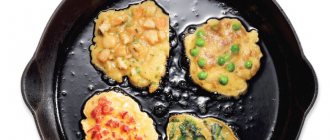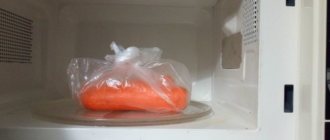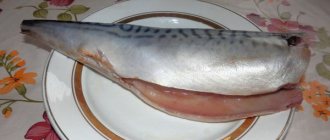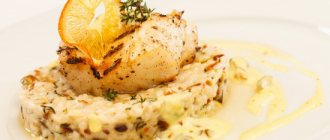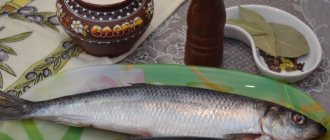Carcasses of delicious, aromatic crustaceans can be served as a main dish or as one of the components of salads, cold appetizers and much more. You should familiarize yourself with the information on how to properly clean shrimp in order to preserve the unique taste of this exquisite, beloved seafood product.
How do you prefer to cook shrimp?
- Fry in a pan 51%, 1488 votes
1488 votes 51%1488 votes - 51% of all votes
- Boil 40%, 1159 votes
1159 votes 40%
1159 votes - 40% of all votes
- Cook on the grill 8%, 234 votes
234 votes 8%
234 votes - 8% of all votes
- Bake 2%, 46 votes
46 votes 2%
46 votes - 2% of all votes
Total votes: 2927
19.05.2020
- Fry in a pan 51%, 1488 votes
1488 votes 51%1488 votes - 51% of all votes
- Boil 40%, 1159 votes
1159 votes 40%
1159 votes - 40% of all votes
- Cook on the grill 8%, 234 votes
234 votes 8%
234 votes - 8% of all votes
- Bake 2%, 46 votes
46 votes 2%
46 votes - 2% of all votes
Total votes: 2927
19.05.2020
×
You or from your IP have already voted.
Frozen Unpeeled
Raw frozen crustaceans should be cleaned in several stages.
- Before peeling frozen shrimp, they must first be thawed, and it is better to do this naturally at room temperature. To speed up the defrosting process, place the carcasses in a colander and keep them under running cold water until defrosting.
- Next, you need to examine the crustaceans to identify those that are not suitable for consumption. Evidence that the shrimp is spoiled is mucus on the surface, a specific smell, and a dull shell.
- It is necessary to separate the head from the body; to do this, grab it with your fingers near the body, hold it tightly and twist it to the sides until it comes off.
- Then they clean the shell, starting from the top, moving to the bottom. The tail can be left or removed at your discretion.
- The shrimp is cut along the central part using a well-sharpened knife, and the intestines are removed using a toothpick. This organ in the crustacean resembles a dark thread that runs along its body.
- The work must be done carefully and slowly. If you clean it quickly and carelessly, the meat will usually taste bitter.
- Rinse the cleaned carcass under running water and dry with a paper towel.
This method is suitable if the crustaceans are large. The above method is not suitable for small specimens for several reasons. The process will take a lot of time and effort, and the resulting product may be spoiled and lose its aesthetic appearance.
How to peel frozen shrimp with a knife
The method differs little from the previous one. The only difference is that the cut along the back is made not with scissors, but with a knife. But if you have to work with small shrimp, then there is nothing better than this option - using a sharp blade you can not only make an incision, but also, if necessary, cut out a fragile wreath.
And in order to enjoy delicious dishes with shrimp without any extra effort and at the same time spy on some interesting ideas for serving them, we recommend visiting the Menza cafe or ordering rolls in Moscow with home delivery.
Cleaning the boiled ones
Very often, shrimp are boiled first, and then cleaned after boiling. In order to clean boiled carcasses, you need to perform the following steps.
- Pour water into the pan.
- Add salt and spices if desired.
- After boiling, throw the required amount of washed crustaceans into the water.
- Cook until the bodies turn pink and float to the surface.
- Remove to a deep cup and cool.
- Take the carcass and separate the legs from it.
- Separate the head.
- Holding the tail, remove the shell.
- The product is ready to use.
How to peel shrimp from the shell using scissors
This is perhaps the least troublesome and safest method, which is suitable for both fresh and boiled seafood. If the head is not needed, it is torn off before further cleaning. And if necessary, the tail of the shrimp is slightly bent towards the abdomen to slightly open the joint between it and the first scale.
Starting from this place, an incision is made with scissors along the center of the back along its entire length. Well, after that you just need to carefully remove the shell and remove the wreath from the resulting cut.
We use scissors
Those who have not yet had experience in cleaning crustaceans are wondering how to clean shrimp so that this work is done quickly and efficiently. You can clean this seafood with your hands, but it’s faster and easier to do this job using scissors.
- Take a raw shrimp, hold the carcass tightly and cut off the head and legs.
- Make a small cut on the back in the central part of the shell and cut further, moving lower towards the tail.
- Remove all shell and hard intestinal vein. If it is difficult to remove or is not visible, an incision should be made on the back.
Fast way
To quickly peel small or large shrimp without damaging them, use this method.
- We load large royal, tiger or ordinary crustaceans into salted water. It is necessary to cook them within 3 minutes from the moment of boiling. Then transfer to cold water. This is necessary so that the durable shell can be easily removed.
- We hold the shrimp with its belly up and separate the head.
- We separate the legs; if there is caviar at their base, you should clean it with a knife and put it in a separate container.
- We hold the central part of the carcass with our fingers, and at the same time, with the fingers of the other hand, we pull the lower part, tightening the shell.
How to quickly peel shrimp while preserving the shell
Usually, seafood comes to the table in this form and serves as decoration. But in order for the “decoration” to also be tasty and edible, the intestinal wreath should be removed from it, because otherwise the impressions may be blurred by the unpleasant crunch of sand on the teeth. How to do this without damaging the shell? It's very easy with a toothpick.
Let's make a reservation right away: the method is applicable only for raw shrimp - the denser meat of boiled shrimp prevents the quality of removing the veins. And it’s pointless to play with small things in this way. But if you have a large fresh or completely defrosted raw shrimp lying in front of you, you should roll its tail into a ring, making the soft joints between the chitin scales and the head accessible.
After this, all that remains is to pierce the vulnerable spot with a toothpick just below the intended location of the wreath and pull it up, as if cutting the meat with a stick. If you see that not all of the wreath has come out, the operation should be repeated at several points along the tail. Having completed the task, all that remains is to slightly correct the puncture sites, hiding the incised flesh under the scales, and cook the shrimp.
Cooking rules
If shrimp are to be served as an independent appetizer, they should be prepared correctly. This is usually done by boiling or frying. Below is a simple way to cook crustaceans.
You should pour the required amount of water into the pan, depending on the number of shrimp. It is advisable to add citric acid or spices to the water to your taste, this will make the seafood more flavorful.
After the water boils, throw in the crustaceans and wait for them to emerge. Remove the finished shrimp to a wide dish.
You can fry peeled crustaceans in a frying pan. To do this, heat vegetable oil on the bottom, add a small amount of rosemary, add seafood, fry on both sides until the shell darkens.
It is recommended to place the finished product on a paper towel to absorb excess fat. Finally, decorate the fried carcasses with herbs.
The tips below will be useful for those who first decided to cook this seafood on their own.
How long to cook frozen peeled shrimp?
How long to cook frozen cleaned seafood? Cleaned sea creatures do not need to be cooked; they can be poured with boiling water for 3-4 minutes and allowed to brew.
If you want to play it safe, you should cook them for no more than 1 minute. Readiness is determined by color. The finished crustaceans will turn a juicy orange color.
The most simple recipe for cooking seafood:
- Rinse the shrimp under cold filtered water.
- Boil 1.5–2 liters of water (depending on the amount of product).
- Add salt to taste, 3-4 bay leaves, black peppercorns (optional). Mix everything well.
- After the water boils, add shrimp and stir. Cover with a lid and wait for it to boil.
- As soon as they boil, wait 1 minute, turn off and immediately drain the water.
- The dish is ready!
Important ! Be careful not to overcook these crustaceans. Otherwise they will become hard like rubber. Unpeeled shrimp are cooked for no more than 3 minutes, and peeled shrimp for 1 minute.
Things to consider before cleaning shrimp:
- Small individuals are less cleaned than large ones, and in the process of removing the shell and other elements, the meat may deteriorate. For this reason, it is better to choose large king or tiger shrimp.
- Uncleaned carcasses can be used for appetizers and salads, while only peeled specimens should be added to soups and many other hot dishes.
- When it comes to how to peel king prawns, you need to boil them first, and then begin this process.
- Boiled crustaceans must be eaten within 5 days. Raw carcasses after purchase are stored in the refrigerator for 2 days. The shelf life of the frozen product is 6 months when stored in the freezer.
How to properly cook king prawns?
King prawns get their name from their large size.
Let's look at how many minutes they cook in the table below:
| View | Cooking time |
| Royal Unpeeled Frozen | 10 minutes |
| Royal unpeeled boiled-frozen | 5 minutes |
| Royal peeled | 3 minutes |
Try this simple recipe for fried seafood:
- Pour some oil into a frying pan and add frozen king prawns.
- Let's make the fire smaller.
- Cover with a lid.
- As soon as they are browned, turn them over.
- Add salt and spices to taste (cumin, turmeric, garlic, dill).
- Cover with a lid for about 1 minute and turn off.
Important ! Do not overcook the shrimp in the pan, otherwise they will be tough.
How to choose the right one
There are more than 2,000 types of shrimp, but you don't have to memorize them. It is enough to know that there are warm-blooded animals that live in warm seas, and cold-blooded animals that live in cold seas.
The first include royal, tiger and other large varieties. They come from China, Thailand, Indonesia, Asia. And the second, smaller category comes from Norway, Estonia, Denmark and other countries. The smaller the individual, the cheaper it is, but at the same time more useful. At the same time, in European countries, products undergo mandatory sanitary control, which is very rare in Asian countries.
Most people think that it is more profitable to buy already peeled shrimp. But that's not true. If you learn how to properly clean seafood, there will be minimal waste left, and home-cooked seafood is not only much tastier, but also healthier.
When choosing products, you need to pay attention to:
- manufacturer information. It should be as complete as possible with address and contact numbers;
- caliber. These numbers make it possible to navigate the size of the shrimp. For example, if it says 1 kg - 100/120, then there are 100-120 pieces in one kilo. If shrimp are sold without heads, the caliber is most often given at 450 g (lb) in weight.
- appearance. This seafood should have a curled tail and an even, smooth color. Old individuals have dry shells, yellowish flesh, and dark spots or spots on their legs. If the shrimp's tail is bent, it was most likely already frozen;
- ice and snow in a bag. They shouldn't exist. This is a sign of repeated re-freezing;
- head color. The most useful are brown ones. These are pregnant shrimp. In second place are those with gray heads. These are ordinary individuals. There is no need to be afraid of green heads, this is simply a sign of feeding on one of the types of plankton. A black head indicates a serious illness, so buying them is strictly prohibited.
Frozen individuals are small in size, cold-blooded, have a gray-brown color and a tucked tail - the best choice.
Note!
Seafood cannot be sold chilled. They have too short a shelf life.


